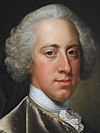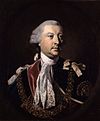Místokrál v Irsku


Místokrál v Irsku (anglicky Lord Lieutenant of Ireland) je historické označení úřadu královského místodržitele v Irském království, který v Irsku zastupoval anglického, respektive britského panovníka. Po připojení Irska k Anglii se kompetence i název funkce místodržitele měnily (Lord Deputy, Chief Governor, Lord Lieutenant). Až po Slavné revoluci a svržení dynastie Stuartovců se ustálilo pojmenování funkce jako Lord Lieutenant in Ireland, neformálně místokrál (Viceroy), ve starších českých zdrojích generální guvernér.[1] Zatímco ve starších dějinách Irska zastávali funkci místodržitele převážně rodilí Irové, po restauraci Stuartovců byli do úřadu jmenováni převážně angličtí peerové. V 17. a 18. století zastávali post tři členové významného starobylého irského klanu Butlerů, kteří měli na Irsko majetkové a příbuzenské vazby. Naopak později v době politické stability se na post irského místokrále dostali dvořané, kteří předtím neměli s Irskem vůbec žádný kontakt (vévoda z Dorsetu).[2] Od poloviny 18. století bylo obsazení postu irského místokrále podmíněno volebními výsledky v Anglii a funkce byla obsazována v návaznosti na změnu vládního kabinetu v Londýně, nadále to byli bez výjimky příslušníci nejvyšší aristokracie provázaní i mezigeneračně blízkými příbuzenskými vztahy. Irský místokrál měl poměrně rozsáhlé pravomoci včetně možnosti povyšování do šlechtického stavu. S rostoucí korupcí se to projevilo především koncem 18. století během vyjednávání o sloučení Británie s Irskem. Faktickým vykonavatelem státní správy byl ministr pro Irsko (Chief Secretary for Ireland), který měl od sloučení Británie s Irskem v roce 1801 statut státního sekretáře s členstvím v britské vládě. Přestože se jednalo o politickou funkci, až do 20. století nebylo nijak výjimečné, že ministrem pro Irsko byl některý z příbuzných místokrále.
Irský místokrál byl z titulu své funkce automaticky členem irské Tajné rady, po dobu výkonu úřadu byl zároveň velmistrem Řádu sv. Patrika. Manželka místokrále byla neoficiálně označována jako Vicereine. Jako rezidence místokrále sloužil královský hrad v Dublinu (Dublin Castle). Podle tradice má každý místokrál v kapli dublinského hradu vyobrazen svůj erb, buď ve vitrážových oknech nebo vyřezávaný v lavicích.
Funkce irského místokrále zanikla po vyhlášení nezávislosti Irské republiky v roce 1922. Protestantská část ostrova zůstala součástí Spojeného království jako Severní Irsko, kde byl jmenován generální guvernér.
Seznam irských místokrálů od konce anglické občanské války do vyhlášení nezávislosti Irska (1660–1922)
Odkazy
Literatura
- MARTIN, F. X; MOODY, T. W, a kol. Dějiny Irska. Praha: Nakladatelství Lidové noviny, 2003. ISBN 80-7106-656-7.
- O'MAHONY, Charles: Místokrálové v Irsku
Externí odkazy
 Obrázky, zvuky či videa k tématu irský místokrál na Wikimedia Commons
Obrázky, zvuky či videa k tématu irský místokrál na Wikimedia Commons
Reference
- ↑ Ottův slovník naučný, díl XII.; Praha, 1897 (reprint 1998) s. 749 ISBN 80-7185-157-4
- ↑ KOVÁŘ, Martin: Velká Británie v éře Roberta Walpola; Praha, 2003 s. 196–208 ISBN 80-86642-23-2
Média použitá na této stránce
Archibald William Montgomerie, 13th Earl of Eglinton, 1st Earl of Winton KT PC (29 September 1812 – 4 October 1861)
Portrait of John Pratt, 1st Marquess Camden
Portrét George Montagu, 2. hrabě z Halifaxu (1716-1771).
Hugh Fortescue, 2nd Earl Fortescue (1783-1861). Engraving by W Holl from a painting by George Hayter
His Excellency Lord Aberdeen
Charles Talbot, 1st Duke of Shrewsbury, by Sir Godfrey Kneller, Bt (died 1723). See source website for additional information.
This set of images was gathered by User:Dcoetzee from the National Portrait Gallery, London website using a special tool. All images in this batch have been confirmed as author died before 1939 according to the official death date listed by the NPG.(c) St John's College, University of Cambridge; Supplied by The Public Catalogue Foundation
William à Court 1st Baron Heytesbury
Courtesy of the National Gallery of IrelandIvor Churchill Guest, 1st Viscount Wimborne (16 January 1873 – 14 June 1939)
Lord Londonderry, 6th Marquess
George Townshend, 1st Marquess Townshend (1724-1807). The port city Port Townsend was named after him
George William Frederik Villiers, Graf Clarendon, englischer Staatssekretär des Auswärtigen, 1865.
Woodburytype of "The Duke Of Abercorn". James Hamilton, 1811-1885. Nobleman and statesman.
Richard Colley Wellesley, Marquess Wellesley, by John Philip Davis ('Pope' Davis) (died 1862). See source website for additional information.
This set of images was gathered by User:Dcoetzee from the National Portrait Gallery, London website using a special tool. All images in this batch have been confirmed as author died before 1939 according to the official death date listed by the NPG.Henry William Paget, 1st Marquess of Anglesey, by George Dawe (died 1829). See source website for additional information.
This set of images was gathered by User:Dcoetzee from the National Portrait Gallery, London website using a special tool. All images in this batch have been confirmed as author died before 1939 according to the official death date listed by the NPG.James Butler, 1st Duke of Ormonde, by William Wissing (died 1687). See source website for additional information.
This set of images was gathered by User:Dcoetzee from the National Portrait Gallery, London website using a special tool. All images in this batch have been confirmed as author died before 1939 according to the official death date listed by the NPG.Robert Offley Ashburton Milnes, 1st Marquess of Crewe
- pastel with pencil
- 38 x 26 cm
- inscribed b.l.: Crewe
- signed b.r.: W. STRANG / 1907
Stephen Slaughter, Henry Boyle, 1st Earl of Shannon, mid-18th century, in Ballyfin Demesne
Autor: unknown, Licence: CC BY 4.0
George William Frederick Howard, 7th Earl of Carlisle. Stipple engraving by H. Cook, 1840.
Iconographic Collections
Keywords: Henry R. Cook; George William Frederick Howard
Autor: Wikimandia, Licence: CC BY-SA 4.0
Arms of Ponsonby: Gules, a chevron between three combs argent.
Charles Lennox, 4th Duke of Richmond and Lennox KG, in scarlet coat with green facings and gold epaulettes, wearing the breast-star of the Order of the Garter, signed and dated 'Copied by H Collen 1823',
Autor: Wikimandia, Licence: CC BY-SA 4.0
Arms of Eliot of Port Eliot: Argent, a fess gules, between two bars gemel wavy azure
Thomas Hamilton
William Ward, 2nd Earl of Dudley, the Governor General of Australia (1908-1911).
Charles Manners, 4th Duke of Rutland, oil on canvas by Joshua Reynolds, c. 1775
Frederick Howard, 5th Earl of Carlisle
Lord Paulet
Portrait of General Monck
William Cavendish, 3rd Duke of Devonshire
Charles Whitworth, later 1st Earl of Whitworth (1752-1825)
Autor: Tony Webster from Portland, Oregon, United States, Licence: CC BY 2.0
Dublin
Autor: Wikimandia, Licence: CC BY-SA 4.0
Arms of Berkeley family: Gules, a chevron between 10 crosses patée argent, six in chief and four in base
A three-quarter-length portrait of William Cavendish-Bentinck, 3rd Duke of Portland, turned to the left, gazing to the left, seated in a red upholstered armchair, holding some papers with his left hand and his cheek leaning on his right hand. Dressed in dark crimson velvet coat and knee-breeches, with white stockings, Short powdered wig, tied at the back with a black ribbon. Architectural background with pillard portico on the left, with view of trees and sky. On the
table are books, and two bronze statuettes, one representing either Samson or Hercules holding the jawbone of an ass, the other possibly a boxer.William Humble Ward, 2nd Earl of Dudley (1867-1932), apparently in his uniform as Grand Master of the Order of St. Patrick and wearing the Irish Crown Jewels
Thomas Herbert, 8th Earl of Pembroke, by John Greenhill (died 1676). See source website for additional information.
This set of images was gathered by User:Dcoetzee from the National Portrait Gallery, London website using a special tool. All images in this batch have been confirmed as author died before 1939 according to the official death date listed by the NPG.Portrait of John Poyntz, 5th Earl Spencer (1835-1910),in a hunting jacket
- pastel, oval, on paper
Photo (by me, R. de Salis, Rodolph (talk) 23:51, 18 August 2015 (UTC)) of a detail of a mezzotint portrait by John Jones (circa 1745-1797) after George Romney of John Fane, 10th Earl of Westmorland, 1796.
John, 2nd Earl of Buckinghamshire (1723-1793)
- oil on canvas
- 127.3 x 99.7 cm
Autor: unknown, Licence:
Portrait of Charles Spencer, 3rd Earl of Sunderland (1675-1722)
"Charles Cornwallis, 1st Marquess Cornwallis," stipple engraving, by Benjamin Smith, published by John Boydell, after John Singleton Copley. Courtesy of the National Portrait Gallery, London.
Portrait by Sir Peter Lely of Henry Capel (1638–1696), Baron Capel of Tewkesbury, the younger brother of Mary and Elizabeth Capel, and Arthur Capel (1632–1693), first Earl of Essex. The picture may have been painted on the occasion of Henry Capel's marriage to Dorothy Bennett in 1659. They lived at Cassiobury House, Watford. The portrait was sold with other Cassiobury estate assets in 1922-3 and now hangs in the Metropolitan Museum of Art in New York.
Lord Zetland
Autor: http://en.wikipedia.org/wiki/User:Ugen64, Licence: CC BY-SA 3.0
The Rt Hon. 4th Earl of Carnarvon
Photograph of the British Field Marshal, Sir John French, Commander in Chief of the British Army from 1914-15































































































































































